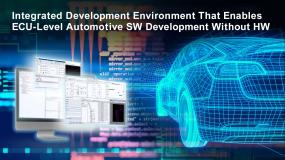Renesas Electronics has launched an Integrated Software Development Environment allowing engineers to rapidly create software for automotive ECUs (Electronic Control Units) containing multiple hardware devices.

New integrated software development environment from Renesas Electronics supports multi-chip ECUs, reducing development time and post-design modifications. The fully integrated environment supports co-simulation, debug and trace, high-speed simulation and distributed processing software over multiple SoCs (System-on-Chips) and MCUs (Microcontrollers)—all without the need for actual hardware.
This software development environment recognizes the automotive industry’s shift toward “Software First” product development, in which a vehicle’s value is increasingly defined by its software, as well as the “Shift Left” software design approach, which emphasizes software verification and validation earlier in the development cycle, before hardware is available. The first development environment tools are available now for the- R-Car S4 and RH850/U2A devices.
This new development environment adds value to the vehicle and establishes a Software First approach. By providing a simulation environment from early stages of product development, the platform enables verification and application development before production of actual devices and ECUs, realizing the Shift Left concept.
The integrated environment offers the following development support :
1. Co-simulation environment for multi-devices facilitating optimal system design :
Designs can now be optimized by balancing different application functions and incorporating software verification at the systems level. A development tool that automatically generates software code for devices and a simulation environment for verification from MATLAB® /Simulink® models will also be available.
2. Debug and trace tool for multi-devices to visualize problems :
Allows simultaneous and synchronized execution, execution control by breakpoints and information tracing for ECUs containing multiple devices.
3. High-speed simulator for software development that achieves rapid and large-scale simulations :
This simulator is based on QEMU, an open-source virtual environment that models SoCs and microcontrollers at a high level of abstraction, enabling faster ECU-level simulation of complex software.
4. Distributed Processing Software for multi-devices that enables design without considering hardware configuration :
This software enables optimal distribution of application functions to CPUs and IPs inside different SoCs and microcontrollers in an ECU, maximizing hardware performance.






